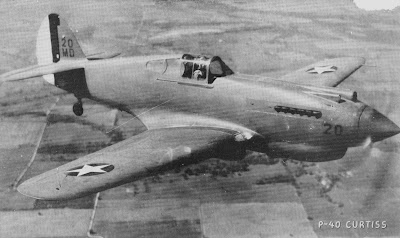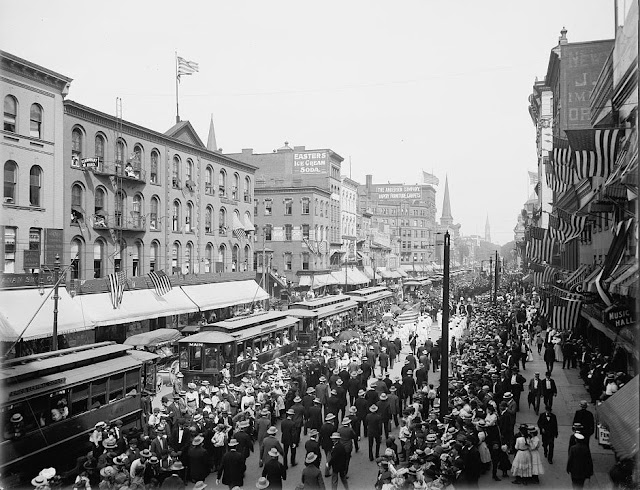 |
P-40's Being Assembled - C-46 Assembly
in background |
Doctors gave the victims first aid before they were sped to several hospitals. The entire Air Raid Precaution Disaster Unit of the Curtiss Plant was called into service, and functioned efficiently.
City, State and Cheektowaga Police and Deputy Sheriffs sped to the factory and barred the public from airport and plant grounds. Word of the accident attracted hundreds of persons but none was permitted to venture close to the scene of the disaster. One Curtiss worker who declined to give his name, said "the plane was pulverized when it hit the floor, you couldn't find a piece bigger than a bushel basket."
A competent observer estimated the plane took fire at 5:15 p.m. at 15,000 Ft., nearly three miles up. Pilot Purnell turned the plane over, pulling the release lever that allowed him to drop out while he was upside down in the single seat. The plane hit the lower part of the factory roof on an angle. The wings were ripped off, but the rest of the machine ripped a six foot hole in the roof and hit the concrete floor on the inside.
 |
| P-40 like the one that crashed |
Engine Buried in Floor
The planes engine buried itself in the concrete flooring. The fuselage skidded 60 feet along the floor, disintegrating and scattering parts over a 30 ft radius as it went. Gas, thrown from the planes fuel tank was ignited turning on the automatic sprinkler system.
Several thousand second shift workers were on duty when the crash occurred, but despite haze, smoke and flame, there was no panic.
Men assigned to the disaster unit under the leadership of Roscoe S. Harmon, sprang into action, snatching blankets from the walls wrapping them around their heads and plunging into the densest smoke to save fellow workers. Flying debris caused some injuries, and others were scorched trying to pull colleagues to safety.
"That was what we thought at first-a bombing". Winston J. ("Tex") Dandrew 24 of 498 Delaware Ave. declared from his bed at Edward J. Meyer Memorial Hospital. "But there really wasn't time to think much of anything, everything happened so fast. First there was the crash of the plane through the roof and then, almost simultaneously it seemed, a blinding flash occurred as the plane exploded... Bits of plane and metal went shooting in all directions. It is hard for me to understand how I escaped alive. I couldn't have been more than one or two feet to the side of the edge of the hole above me. A piece of metal knocked me in the arm, but aside from that the flying pieces of metal and flames seemed to miss me.
 |
| C-46 also made at the Curtiss Plant |
Says Scene Was Indescribable
Right near me a man was knocked against a ladder and had difficulty extracting himself. I pulled him free and we both ran as fast as we could. Later we came back to help the other injured and to help put out the fire. Dandrew said the scene of human agony all around him after the explosion was most indescribable.
The first part of the tragedy--was told by persons near the airport. "When I first saw it the plane was very high to the south west of the port, said John J. Kennuth of 253 Maple Street a
Van Dyke Coach driver. "It was already burning and I could see the parachute of the pilot who had bailed out, some distance away." "
It came nearer and nearer to where I was standing at the auto entrance for the airport building. For a while I thought it was going to hit the airport building. I wanted to run, but I couldn't. I was scared stiff and couldn't move." Then the plane swept over the Curtiss roof and crashed. Black smoke poured out 30 to 40 feet high."
Workmen Describe Crash
"I heard a terrible noise overhead, then flames and sparks began shooting down from the roof," Steve Kovach, 21, of 113 Rosedale Ave., Riverside, one of the injured workmen said. "I was working with two other fellows when it happened.," Mr. Kovach related at his home after being treated at Meyer Hospital. We started to run for the door. Flames shot down at us. I was lucky not to have been burned worse." Mr. Kovach was burned on both arms and neck when flaming gasoline spurted over the workers as the plane struck.
 |
| My Mothers Curtiss-Wright Crew - (2nd from Rt. 2nd row) |
Editor: My mother Julia (Stanek) Malloy, who worked at the Curtiss plant from 1942 to the end of the war, was working in the P-40 assembly area where the plane crashed. She relates "when the plane hit, we could feel the heat on our backs. Then someone yelled "FIRE" and men rushed from all directions grabbing the fire hoses off the wall and heading to the scene. The Plane crashed into the tool crib, a fenced in area, making escape difficult for the victims. When the fire was out we watched as the dead and injured were being carried out on stretchers. The water was so deep in our area our foreman told us we couldn't work in that, and sent us home."
 |
A Navy "E" Award Given to the Plant About 20 Days
Before the Tragedy |
A Curtiss Wright guard who was burned severely on both arms Friday while rescuing fellow workers injured in the plane crash...donated his blood to the American Red Cross to aid suffering survivors. Although his bandaged arms bore testimony to the heroic part he played in the tragedy,
Herbert Boxhorn, 26, of 46 Inter Park, was among the first of more than 50 Curtiss employes who appeared at the blood donor center in the Ellicott Square. Although Boxhorn modestly minimized his heroic role, other Curtiss workers disclosed that he risked his own life to carry four injured workers to safety. One of the severely burned men he helped carry from the smoke filled plant died a few minutes later. (
Herbert Boxhorn is a name not included on the injured list)
*
Quarterly of the National Fire Protection Association, Vol., 36, No. 2, October 1942, pp. 137-138.
"When the plane crashed through the roof, gasoline released from the fuselage tank caused an extremely hot fire. Plant employees immediately sounded the alarm over three private fire alarm boxes and 90 members of the plant fire brigade responded and did excellent work in extinguishing the fire. They were aided by the operation of 208 automatic sprinkler heads on a wet-pipe system. Fortunately, the falling plane had not seriously damaged the sprinkler piping, although a 174-inch sprinkler pipe and a 6-inch commercial water service line suspended from the ceiling were ruptured. These pipes released considerable quantities of water, which flooded a large area.
 The plant engineer
The plant engineer on duty upon hearing the crash immediately consulted the water pressure gauge and noticed that the pressure had dropped to twenty pounds. He started the 1500 g.p.m. electrically driven fire pump and started to warm up the 1500 g.p.m. steam turbine pump which was placed in operation. A pressure of 75 pounds per square inch was maintained at both pumps.
The prompt application of the foam and carbon dioxide was helpful in preventing the gasoline burning on the surface of the water from spreading the fire. It is estimated that the fire was under control in 15 minutes and was completely out in 30 minutes.
“The fall of the blazing plane was observed by members of Engine Co. 7 of the Buffalo Fire Department, stationed at the Buffalo Airport. This company, assuming that the plane would fall in a field beyond the building, responded at 5:15 P.M. with a crash truck equipped with foam and carbon dioxide equipment, and with a 1000-gallon pumper. Neither piece of apparatus was used, but the fire company rendered valuable service in manning one of the private standpipe hose streams, removing the injured to the first aid station, pumping out the flooded area below the ground level, and in covering the damaged roof….” (Wright. NFPA Quarterly, Oct. 1942, 137.)
Management Statement: "Concerning the heroism of the Curtiss workers--I cannot say enough. Many risked injury and even their lives in rescuing their fellow employees from the flames that followed the crash. Some of the rescuers are among those now in hospitals." "Curtiss guards, members of the volunteer fire-fighting and air raid precaution units and individuals from office and factory staffs, performed these extra duties without once hesitating to reckon the cost or to think of their personal danger.
"All other workers in the plant at the time, who may not have participated directly, showed their mettle by their calmness and by the manner in which they remained at their work. I would like to express the heartfelt thanks of the management to all, including the outside agencies that so readily volunteered their help. It is a great tribute to those on the battlefront, that those on production front are carrying on normally today with true American fighting spirit."
The final toll of those who died was 14 with 34 injured,
many seriously.
Those who died in this tragedy
Jack H. Boyer, Paul Chase, Cecil Clark, James E. Collins, Lester F. Glenn, Salvatore Palmeri, Carlson M. Rauh, Francis Ryan, Norman Savage, Joseph J. Sciolino, Samuel Shalala, Martin Till, Laverne Voelker, Frank Warda
Those Who Were Injured
Edward Buehler, Winston Danarow, James Doucette, Andrew Fiorella, Edward Harrison, Raymond Hartwig, Frank Head, James Herdic, Louis Jakubowski, William Kenny, George Kitta, Steve Kovach, Newton Kranso, Michael Kuzara, Frank Laber, Louis Malinowski, Grace Marlotte, Harry Mills, Clarence Moorhouse, Sager Nebral, Merwin Nellis, Rocco Orioli, Lawrence Preischel, Jack Purnell, Joseph Rosolowski, Geraldine Scott, Thomas Sheppard, Edward Shoemaker, Chester Stubensz, Roman Swiniuch, Truman Taggert, Leon Thompson, Dominic Visone, Raymond Yager
This is from the Memorial Mass booklet put out by Curtiss-Wright to commemorate those who died or were injured in the accident of 9/11/1942. If you would like a free, complete copy of the entire Memorial booklet just click on the following words; Curtiss Memorial (For a larger view of above, click on picture)
 |
This Plaque is currently located near the Long
Term Parking lot at the Buffalo Airport. Info
thanks to Dan's comment below.
|
EDITORS NOTE: I was amazed to discover when researching this story, that there was no information on the internet regarding this accident, like it never happened! There may have been some document or source somewhere that I didn't discover, but an exhausting search on Google and others turned up nothing, not even a hint of it!
I only highlighted the story here, to make people aware and maybe do further research on their own if need be. These people served their country just as any soldier did and paid the ultimate sacrifice. They should not be forgotten. These veterans of production are disappearing. My Mother, whom I'm very proud of, worked at the plant when this tragedy happened, less than a hundred feet away from the crash. These stories need to be recorded as first line history before it is too late.
For those who will be leaving a comment below, be aware that they will not appear immediately. All comments are moderated by myself to screen out spam comments which are numerous. I check every few days so be patient, if on topic they will appear.
 |
| Looking for Rosie |









































